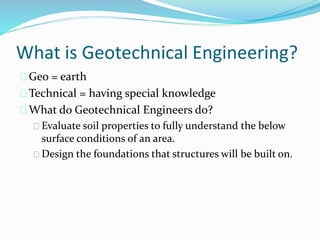The Definitive Guide to Geotheta
The Definitive Guide to Geotheta
Blog Article
Getting My Geotheta To Work
Table of Contents4 Simple Techniques For GeothetaWhat Does Geotheta Mean?Excitement About GeothetaThe Best Strategy To Use For GeothetaThe 6-Second Trick For Geotheta

They carry out website investigations, gather examples, execute lab tests, and examine data to examine the viability of the ground for building jobs - Tailings Engineer. Based on their searchings for, geotechnical designers supply referrals for structure style, incline security, preserving frameworks, and reduction of geotechnical threats. They collaborate with other specialists, such as architects, structural engineers, and construction groups, to ensure that geotechnical considerations are incorporated right into the general project layout and execution
By assessing the habits and buildings of soil and rock, they can determine possible geotechnical threats such as landslides, dirt settlement, or incline instability. Their proficiency helps protect against failures or mishaps that might jeopardize lives and residential or commercial property. Here are some comprehensive responsibilities and responsibilities of a geotechnical engineer: Website Investigation: Geotechnical engineers conduct website examinations to collect data on subsurface problems.
They interpret the information to recognize the homes and habits of the soil and rock, including their strength, leaks in the structure, compaction features, and groundwater conditions. Geotechnical Evaluation and Layout: Geotechnical engineers analyze the information collected throughout website investigations to evaluate the stability and viability of the site for construction tasks. They execute geotechnical estimations and modeling to examine elements such as bearing ability, negotiation, incline stability, side earth pressures, and groundwater flow.
The Ultimate Guide To Geotheta
Structure Design: Geotechnical designers play a crucial function in developing structures that can safely support the desired framework. They evaluate the dirt problems and tons demands to determine the suitable structure kind, such as shallow structures (e.g., footings), deep foundations (e.g (https://penzu.com/p/952dfde2dba9ee4f)., heaps), or specialized strategies like soil improvement. They think about elements such as negotiation limits, bearing capability, and soil-structure interaction to develop optimum structure styles
They evaluate construction plans, monitor site tasks, and perform field assessments to verify that the layout suggestions are followed. If unanticipated geotechnical issues arise, they examine the situation and give suggestions for remediation or changes to the style. Danger Evaluation and Reduction: Geotechnical engineers examine geotechnical hazards and dangers connected with the task site, such as landslides, liquefaction, or dirt erosion.

Collaboration and Interaction: Geotechnical engineers function very closely with other specialists associated with a project, such as designers, architectural engineers, and building and construction groups. Effective communication and partnership are important to integrate geotechnical factors to consider into the general project layout and building procedure. Geotechnical engineers give technical know-how, solution queries, and ensure that geotechnical demands are fulfilled.
The Greatest Guide To Geotheta
Below are some sorts of geotechnical designers: Structure Engineer: Foundation engineers concentrate on developing and assessing structures for structures. They analyze the soil problems, lots needs, and website characteristics to identify the most suitable foundation type and layout, such as shallow structures, deep structures, or specialized methods like heap structures.
They evaluate the factors influencing incline stability, such as dirt residential properties, groundwater problems, and slope geometry, and develop approaches to avoid slope failings and reduce dangers. Earthquake Engineer: Quake designers specialize in evaluating and creating frameworks to withstand seismic pressures. They examine the seismic threat of a website, assess soil liquefaction possibility, and establish seismic style criteria to make certain the security and strength of frameworks during earthquakes.
They carry out field testing, accumulate samples, and assess the gathered information to characterize the soil homes, geologic developments, and groundwater problems at a site. Geotechnical Instrumentation Engineer: Geotechnical instrumentation designers focus on surveillance and measuring the actions of soil, rock, and frameworks. They set up and maintain instrumentation systems that keep an eye on elements such as dirt settlement, groundwater degrees, slope activities, and architectural displacements to assess efficiency and offer very early warnings of potential problems.
Geotheta Fundamentals Explained
They conduct tests such as triaxial examinations, loan consolidation tests, direct shear examinations, and permeability tests to gather information for geotechnical evaluation and layout. Geosynthetics Engineer: Geosynthetics designers concentrate on the design and application of geosynthetic materials, such as geotextiles, geogrids, and geomembranes. They utilize these products to boost dirt security, strengthen inclines, supply drain solutions, and control disintegration.
They have a tendency to be investigative people, which means they're intellectual, introspective, and investigative. They wonder, systematic, sensible, analytical, and sensible. Several of them are likewise social, indicating they're kind, generous, participating, Go Here patient, caring, practical, understanding, tactful, and friendly. Does this sound like you? Take our free profession test to discover if geotechnical designer is just one of your leading job suits.
In the workplace environment, geotechnical engineers utilize specialized software devices to execute computations, produce styles, and evaluate data. They prepare reports, review task specs, interact with clients and employee, and coordinate project tasks. The office setup provides a helpful atmosphere for study, analysis, and collaboration with various other experts associated with the task.
Get This Report on Geotheta
They frequently go to job websites to conduct website examinations, analyze geotechnical conditions, and collect information for analysis. These visits include traveling to various areas, sometimes in remote or challenging surfaces. Geotechnical engineers may carry out dirt tasting, conduct examinations, and display building tasks to ensure that the geotechnical facets of the task are being carried out properly.
Geotechnical engineers also work in specialized geotechnical labs. Geotechnical lab designers work extensively in these atmospheres, managing testing equipment, running instruments, and recording data.
Report this page